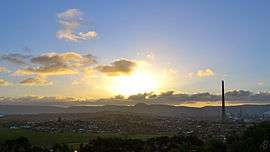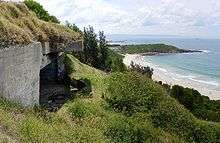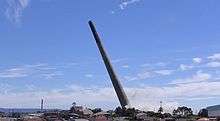Port Kembla, New South Wales
| Port Kembla Wollongong, New South Wales | |||||||||||||
|---|---|---|---|---|---|---|---|---|---|---|---|---|---|
 View of Port Kembla from Hill 60 Park looking North West at Sunset | |||||||||||||
| Coordinates | 34°28′S 150°54′E / 34.467°S 150.900°ECoordinates: 34°28′S 150°54′E / 34.467°S 150.900°E | ||||||||||||
| Population | 4,884 (2011 census)[1] | ||||||||||||
| Postcode(s) | 2505 | ||||||||||||
| Time zone | AEST (UTC+10) | ||||||||||||
| • Summer (DST) | AEDT (UTC+11) | ||||||||||||
| Location | 112 km (70 mi) S of Sydney | ||||||||||||
| LGA(s) | City of Wollongong | ||||||||||||
| State electorate(s) | Wollongong | ||||||||||||
| Federal Division(s) | Cunningham | ||||||||||||
| |||||||||||||
Port Kembla is a suburb of Wollongong 8 km south of the CBD and part of the Illawarra region of New South Wales. The suburb comprises a seaport, industrial complex (one of the largest in Australia), a small harbour foreshore nature reserve, and a small commercial sector. It is situated on the tip of Red Point, first European sighting by Captain James Cook in 1770. The name "Kembla" is Aboriginal word meaning "plenty [of] wild fowl".[2]
History
Before Port Kembla was an industrial suburb of Wollongong, it was a town with a remarkably self-sufficient society, a growing commercial centre, and a vibrant civic life. Town subdivision began in 1908, and by 1921 there were 1622 residents.[3] Economic expansion propelled further population growth. Port Kembla derives its name from its proximity to Mount Kembla.
Industrial change
A copper smelter and refinery, the Electrolytic Refinery and Smelting Company of Australia, began production in 1908, followed by the opening of Metal Manufactures in 1917 and finally the arrival of the Hoskins Iron and Steel Works in 1927. The works became Australian Iron and Steel the following year.
By 1947 the town's population has increased to 4,960 with smaller satellite suburbs such as Cringila and Lake Heights, mushrooming on its fringes.[4] That year, 1947, marked the climax of a local campaign for municipal autonomy which was ultimately thwarted by the creation of a Greater City of Wollongong. In the post-Second World War period there was an inexorable decline of a 'Port Kembla' society as local town boundaries were slowly but surely absorbed into a more Wollongong-focused or regional identity.[5]
Multiculturalism
Despite the decline from the heyday of the 1920s, the town experienced major social and demographic change in the 1950s and 1960s. Waves of migrants, mostly from the United Kingdom, Italy, Macedonia and Germany, moved to the town. During this period, Port Kembla was on the cusp of changes affecting Australian society generally as new ethic and cultural influences found a place in local society.[6] With its long migration history accommodating waves of migrant workers and their families, Port Kembla is still one of the most culturally diverse suburbs in New South Wales.
Hill 60
Port Kembla's highest point, Hill 60, overlooks the Five Islands and Red Point. Hill 60, originally the site of an Aboriginal settlement, was used by the army during World War II to make a coastal gun emplacement known as Illowra Battery. In September 1942, Aboriginal inhabitants were forcibly evicted from the area.[7] It has remained in the army's ownership and is now a public lookout reserve, despite a vigorous campaign to return some of the land to its Aboriginal owners. Although not technically open to tourists, the tunnels are open, and can be explored by foot. The entrance to the tunnels is located almost under the coastguard tower on Hill 60, and can be seen down the left when standing at the information board, facing southeast.[8]
 Dated: 1944 No. 2 gun Illowra Battery, Showing its original BL 6 inch Mk XI gun
Dated: 1944 No. 2 gun Illowra Battery, Showing its original BL 6 inch Mk XI gun Gun position No. 2 at Illowra Battery, which formed part of the Kembla Fortress defences in World War II
Gun position No. 2 at Illowra Battery, which formed part of the Kembla Fortress defences in World War II
Climate
Port Kembla has a warm oceanic climate (Cfb) with humid summers and mild, crispy winters. The suburb enjoys abundant sunshine, getting 111.4 clear days, annually.
| Climate data for Port Kembla (1957-1976) | |||||||||||||
|---|---|---|---|---|---|---|---|---|---|---|---|---|---|
| Month | Jan | Feb | Mar | Apr | May | Jun | Jul | Aug | Sep | Oct | Nov | Dec | Year |
| Record high °C (°F) | 41.9 (107.4) |
36.1 (97) |
39.4 (102.9) |
32.5 (90.5) |
29.4 (84.9) |
25.6 (78.1) |
25.8 (78.4) |
28.3 (82.9) |
35.0 (95) |
35.0 (95) |
39.2 (102.6) |
39.8 (103.6) |
41.9 (107.4) |
| Average high °C (°F) | 24.1 (75.4) |
24.4 (75.9) |
24.1 (75.4) |
22.4 (72.3) |
19.4 (66.9) |
17.5 (63.5) |
16.7 (62.1) |
17.3 (63.1) |
19.2 (66.6) |
20.7 (69.3) |
22.4 (72.3) |
23.4 (74.1) |
21.0 (69.8) |
| Average low °C (°F) | 18.4 (65.1) |
18.7 (65.7) |
18.0 (64.4) |
15.7 (60.3) |
12.7 (54.9) |
10.9 (51.6) |
9.8 (49.6) |
10.3 (50.5) |
11.8 (53.2) |
13.7 (56.7) |
15.3 (59.5) |
17.1 (62.8) |
14.4 (57.9) |
| Record low °C (°F) | 13.3 (55.9) |
13.0 (55.4) |
10.6 (51.1) |
10.0 (50) |
5.6 (42.1) |
5.3 (41.5) |
1.1 (34) |
2.2 (36) |
2.2 (36) |
7.2 (45) |
9.2 (48.6) |
10.0 (50) |
1.1 (34) |
| Average precipitation mm (inches) | 116.1 (4.571) |
157.5 (6.201) |
183.7 (7.232) |
92.9 (3.657) |
89.0 (3.504) |
140.3 (5.524) |
62.6 (2.465) |
87.7 (3.453) |
55.0 (2.165) |
108.0 (4.252) |
94.3 (3.713) |
90.4 (3.559) |
1,260.6 (49.63) |
| Average precipitation days | 11.6 | 12.5 | 13.4 | 9.1 | 8.0 | 9.7 | 7.4 | 9.5 | 8.2 | 11.2 | 11.1 | 11.0 | 122.7 |
| Average relative humidity (%) | 75 | 76 | 74 | 68 | 62 | 61 | 57 | 57 | 61 | 67 | 67 | 72 | 67 |
| Source: [9] | |||||||||||||
Industry and Infrastructure
Port Kembla is known for the BlueScope Steel steelworks operations on Springhill Road and throughout North Port Kembla. Other notable industrial operations in the suburb are: Port Kembla Coal Terminal, Port Kembla Copper, Port Kembla Port Corporation, Incitec, Adstream Services, Port Kembla Gateway and GrainCorp.
Rail
Port Kembla has a railway station on the Port Kembla branch of the South Coast Line. It is the terminus of the branch line, and serves the residential area of the suburb of the same name. The station has one side platform, used for terminating trains. It is served by approximately one train per hour, usually a local service to Thirroul and Waterfall, but extra direct trains to and from Sydney are provided in the peak hours.
Pacific National operates daily coal trains to the Inner Harbour section of the port, and into the blast furnace section of the steelworks. Downer Rail has a workshop opposite the station that services diesel powered locomotives for Pacific National.
Port
Port Kembla Harbour is a major export location for coal mined in the southern and western regions of New South Wales. As part of the state governments plan to divert ships containing auto mobiles, the port has received significant upgrades and infrastructure including a new Maritime Office and many jobs have been created as the need for port logistics grows. Patrick Corporation holds a contract for integrated port services in the harbour and transports goods by road or rail through its parent company Pacific National.

Sports and leisure
Sporting teams
Port Kembla has both junior and senior teams in local popular sporting leagues such as:
- Port Kembla Rugby League in the Illawarra Division Rugby League
Home grounds are Noel Mulligan Oval
- Port Kembla Cricket Club in the Cricket Illawarra Competition
Home grounds are King George V Park
- Port Kembla Soccer Club in the Illawarra Football Association
Home grounds are Darcy Wentworth Park
- Port Kembla AFL Club plays in South Coast AFL and AFL Illawarra
Home grounds are Kully Bay Park.
Port Kembla Rugby League, Port Kembla Soccer Club and Port Kembla AFL home grounds are not located in Port Kembla, they all play in parks across Warrawong.
Parks and beaches
Port Kembla has a number of parks, nature reserves, beaches and a Saltwater Olympic pool:
- King George V Park
A foreshore park located in walking distance from Port Kembla Beach. Used in summer for Port Kembla Cricket Club home games.
- Hill 60 Park
A popular take off area for hang gliders and para gliders, Hill 60 Park has BBQ facilities as well as picnic shelters, seats and tables positioned to enjoy the scenic views.
- Port Kembla Beach
An award winning beach,[10] seasonally patrolled from September to April[11] and home to the Port Kembla Surf Life Saving Club.
- Fishermans Beach
A small sheltered beach at the bottom of Hill 60's eastern side facing the Five Islands Nature Reserve.
- North Port Kembla Beach
Also known by locals as MM Beach for its close proximity to the Metal Manufacturers site on Gloucester Boulevard. Remnants of a tidal rock pool are still standing near the southern end of the beach below the headland.
Public transport
Train
Port Kembla has two railway stations on the Port Kembla branch of the NSW TrainLink South Coast Line.
Port Kembla railway station is the terminus of the branch line, and serves the residential area of Port Kembla. Port Kembla North serves the industrial area of the suburb. The station is the nearest to the BHP Billiton site in the area.
Both stations have a one sided platform, with the platform at Port Kembla used for terminating trains. The stations are served by approximately one train per hour, usually a local service to Thirroul, but extra direct trains to and from Sydney are provided in the peak hours.
Bus
Premier Illawarra runs three routes to and from Port Kembla railway station:[12]
- 34 – to Wollongong via Berkeley
- 43 – to Dapto
- 65 – to North Beach
Health and environmental issues
Port Kembla chimney stack

Port Kembla was home to one of Australia's tallest industrial chimneys, a 198 metre tall chimney built in 1965. Port Kembla Primary School was once located adjacent to it but was closed down due to pollution problems from the chimney including lead contaminated soil, acid rain and soot. A warning alarm was fitted to warn of high toxin levels. In November 2008, the Port Kembla stack was inspected and confirmed to have concrete cancer.[13] The stack was planned to be demolished in early 2010 at a cost of A$10 million.
As of 6 September 2010 the plans to knock down the stack have been revised by the NSW Department of Planning. These plans include demolition of the existing Port Kembla Copper structures surrounding the chimney, excluding the locally heritage listed Precious Metals Mill Chimney and the Assay Offices. The work is now due to start in the middle of 2011 with a team of 30 workers, under supervision by NSW Police, NSW WorkCover and relevant emergency services at a cost of A$8 million with an expected time frame of 16 months.[14]
On 2 August 2013, it was announced that the stack would be demolished on Friday 6 September 2013.[15] Due to asbestos concerns, the demolition was delayed. After no signs of danger were found, a new date was announced for the demolition; 20 February 2014.[16]
On 20 February 2014, the copper stack was demolished.[17]
Industrial pollution

In the past, Port Kembla's industrial heart was associated with significant industrial pollution including emissions of nitrogen oxides and other dangerous gases. However, the air quality around Port Kembla has improved dramatically over the past decade. At nearby Kembla Grange the average concentration of nitrogen dioxide (NO2) measured by the NSW Department of Environment Climate Change halved between 2002 and 2014.[18]
Back in the 1990s health problems were associated with noxious gases. One 1998 study of the industrial areas of Newcastle and Port Kembla found 'an important association between relatively low levels of particulate air pollution and respiratory symptoms' among primary school children.[19] Fallout has also introduced elevated levels of lead and other heavy metals to the soil around Port Kembla and has formed thick deposits in many buildings and industrial structures.[20]
See also
References
- ↑ Australian Bureau of Statistics (31 October 2012). "Port Kembla (State Suburb)". 2011 Census QuickStats. Retrieved 16 April 2015.
- ↑ "PLACE NAMES.". The Australian Women's Weekly. National Library of Australia. 13 May 1964. p. 61. Retrieved 22 February 2011.
- ↑ Commonwealth Census of Australia, 1921
- ↑ Commonwealth Census of Australia, 1947
- ↑ See Erik Eklund, Steel Town: the making and breaking of Port Kembla, pp.131-136
- ↑ Erik Eklund, Steel Town: the making and breaking of Port Kembla, pp. 158-171
- ↑ See Erik Eklund, 'Steel Town: the making and breaking of Port Kembla', MUP, Melbourne, 2002, pp. 114-130
- ↑ Archived 20 November 2009 at the Wayback Machine.
- ↑ "Climate statistics for Port Kembla". Bureau of Meteorology. Retrieved 2 June 2016.
- ↑ Thompson, Angela (2009-12-05). "It's official: Port Kembla's the best beach in NSW - Local News - News - General". Illawarra Mercury. Retrieved 2012-05-26.
- ↑ "Beaches". Wollongong.nsw.gov.au. Retrieved 2012-05-26.
- ↑ http://premierillawarra.com.au/timetables.html#berkeley
- ↑ Illawarra Mercury, 26 November 2008.
- ↑ http://www.planning.nsw.gov.au/DesktopModules/MediaCentre/getdocument.aspx?mid=449
- ↑ Humphries, Glen (2013-08-02). "Demolition day named for Port Kembla stack". Illawarra Mercury. Retrieved 2013-10-24.
- ↑ "Port Kembla stack's finally coming down". Illawarra Mercury. Retrieved 31 December 2013.
- ↑ "Thousands watch Port Kembla Copper stack demolition". ABC News. Retrieved 21 February 2014.
- ↑ NSW Department of Environment Climate Change: Annual Averages NO2 at Kembla Grange – http://www.environment.nsw.gov.au/AQMS/search.htm
- ↑ Peter R Lewis et al, (1998) 'Outdoor air pollution and children's respiratory symptoms in the steel cities of New South Wales', Medical Journal of Australia, 169: pp. 459-463 See
- ↑ "Case study: The Port Kembla Community's Dilemma with Toxic Dust". Lead.org.au. Retrieved 2012-05-26.
External links
| Wikimedia Commons has media related to Port Kembla, New South Wales. |

